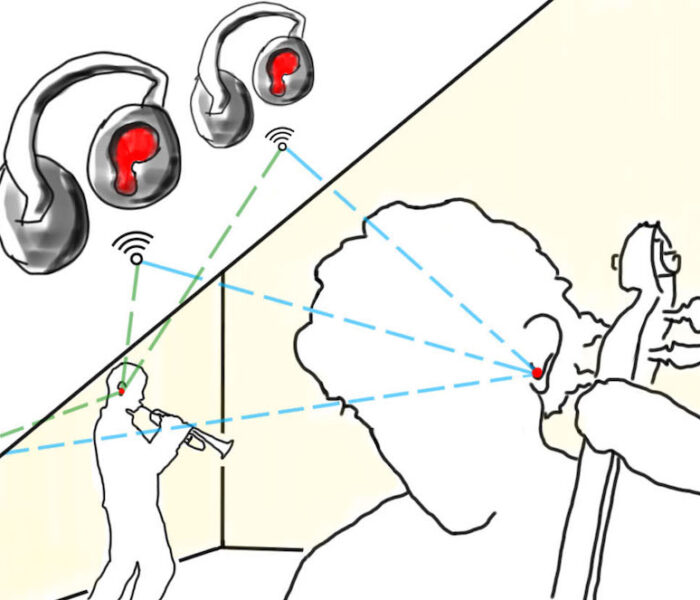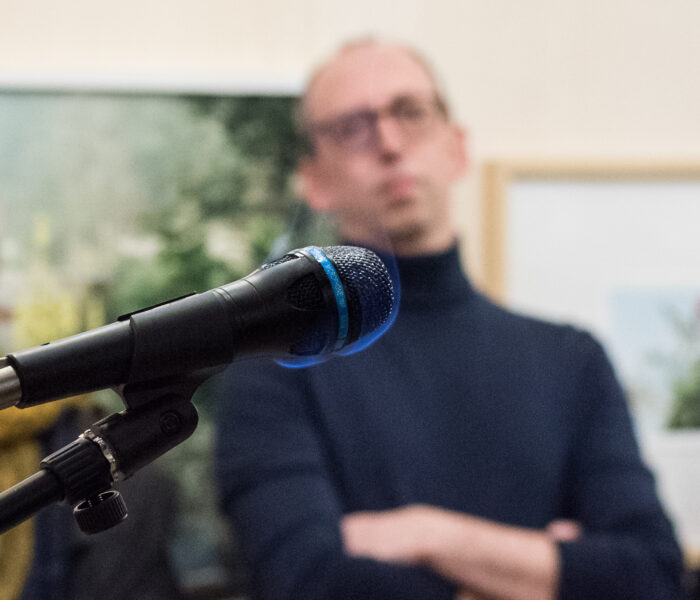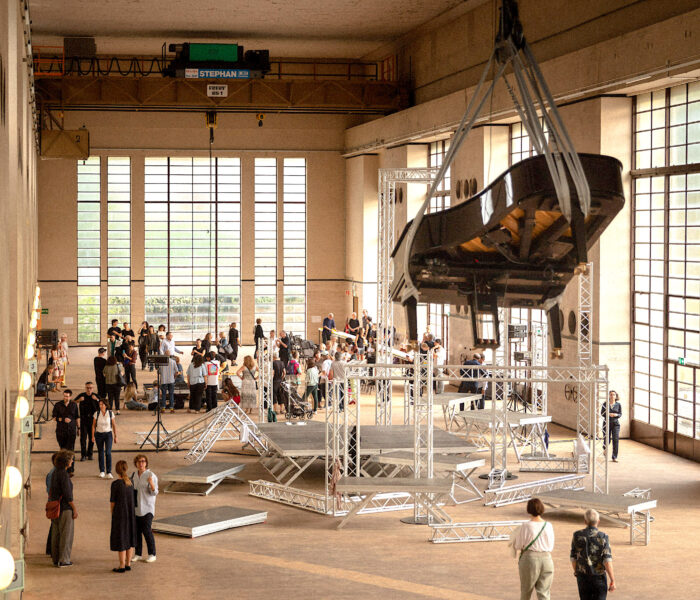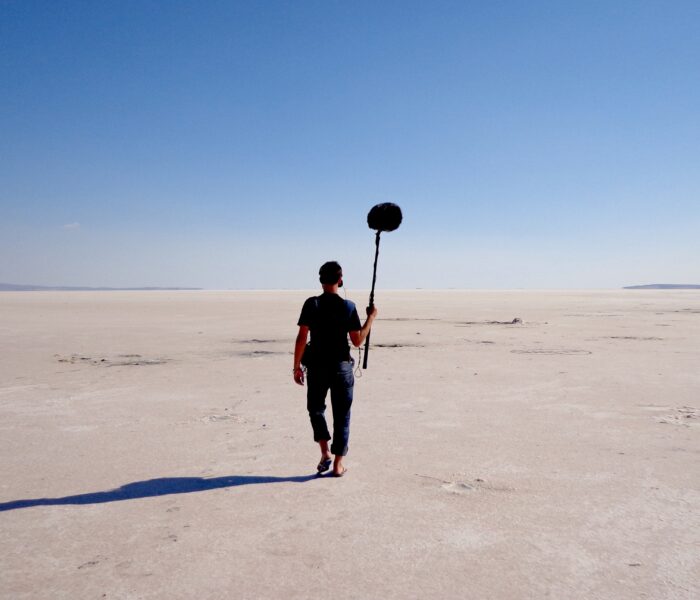Dominique Petitgand (1965) est un artiste que l’on qualifie de “sonore” car tout son univers tourne autour du son et de ses silences. De la création radiophonique, à la performance en passant par des expositions en France et à l’étranger, à travers ses enregistrements et ses livres, son œuvre tout en finesse enchante les oreilles.
Un entretien à Nancy, à l’occasion de son exposition La distance abolie aux Musées des Beaux-Arts, – à découvrir jusqu’au 26 mars – , qui nous permet de revenir sur les différents aspects de son travail, ainsi que son rapport à l’écoute.
Dominique, avant d’explorer ton travail, j’aimerais que tu reviennes avec nous sur ta formation? Qu’est-ce qui t’a poussé à te tourner vers le son?
La question du son a toujours été présente, mais au début elle côtoyait d’autres pratiques que j’avais autour des images : photo, vidéo, cinéma. J’ai fait quelques films, plutôt seul, des films sans scénario ni préparation, pour lesquels l’étape du montage était le moment clef de la composition. Et puis, un jour, le son est resté tout seul. Pour plein de raisons, dont j’ignore la plupart. Peut-être avant tout, parce qu’il a toujours été important pour moi d’être autonome, à toutes les étapes d’une création. Et à l’époque – début des années 90 – un simple micro et une table de montage 4 pistes, c’était un moyen abordable de commencer à faire des pièces, d’expérimenter sans devoir demander une aide technique, une bourse ou une résidence dans un studio, sans avoir à écrire à l’avance un projet, sans sujet déterminé ni compte à rendre à quiconque. Le son me permettait également de mêler et d’imbriquer deux de mes pratiques : d’un côté, travailler avec le réel (la récolte de sons, de voix , tout azimut, puis leur montage et démontage), d’un autre côté, la musique, que j’ai depuis toujours jouée et improvisée sur toute sorte d’instrument ou d’objets.
Ton travail sonore se décline autour de différents formats : installations / diffusions / éditions qui ont chacun leur propre autonomie. Ces formats sont-ils induits par l’environnement ou choisis pour une finalité particulière? Ces formats sont surtout induits par des contextes différents. Même s’il y a de plus en plus de porosité entre les disciplines artistiques, cela dépend, si je dois intervenir dans un lieu d’art ou de musique ou dans un lieu de spectacle, comme récemment pour l’installation Les heures creuses créée au T2G-Théâtre de Gennevilliers. Chacun de ces formats met en jeu des modes différents d’écoute, des stratégies d’apparition et de diffusion des sons, des relations spécifiques à l’espace, à l’acoustique, au silence, au temps et à la place du public. Par exemple, pour une installation sonore, je propose une écoute plutôt solitaire, propice aux déplacements, d’une durée non fixée et libre, à la temporalité longue et circulaire, sans début ni fin. Et surtout, je cherche dans ce cas le lien le plus juste possible entre les sons, le dispositif et le lieu que je prends en compte dans sa nature concrète et son architecture comme par exemple l’installation Quelqu’un par terre
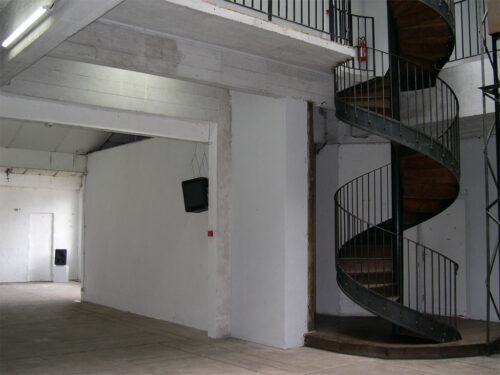
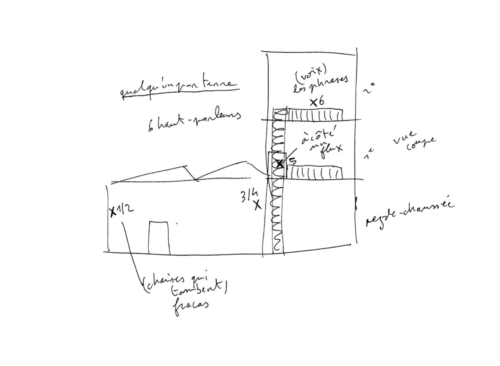

Alors qu’une diffusion dans une salle de spectacle, de type performance ou concert, s’adresse à un public réuni, l’écoute est donc collective, immobile, assise. Et sa temporalité est plus resserrée, linéaire, avec forcément un début et une fin. Passer d’un format à un autre, m’a ainsi poussé, au fil des années, pour pouvoir réagir aux contextes et aux supports, à réaliser de multiples versions de mes pièces : versions stéréos ou versions multi-pistes, versions complètes ou désossées couche par couche, avec voix seules ou accompagnement, avec ou sans musique, avec traduction parfois. Mais aussi versions courtes et concentrées, en forme de miniatures, ou versions prolongées, en variations et répétitions, entrecoupées de silences et bouclées sur elles-mêmes. La durée des silences dépendant également du mode d’écoute, du degré d’isolement de l’œuvre, d’éventuelles autres sollicitations sonores, donc, effectivement, de l’environnement. Et toutes ces versions peuvent révéler de multiples facettes d’une même œuvre, en mettant en avant sa nature narrative, son intrigue et ses éléments de dramaturgie, ou bien, dans d’autres circonstances, en privilégiant sa nature linguistique – l’énonciation et l’emploi de la langue, la parole prise au piège du montage -, ou encore, au contraire, sa musicalité. Voir le cycle de quatre performances, Les gens assis par terre.
En tous les cas, d’un format ou d’une version à l’autre, les enjeux, pour moi, restent les mêmes : il s’agit toujours de créer les conditions d’une expérience à vivre, d’un récit à découvrir par étapes, d’une énigme suspendue, d’un sens multiple à inventer par tout le monde, et d’une écoute la plus libre possible.
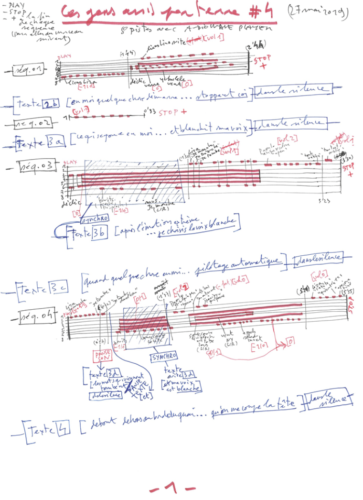
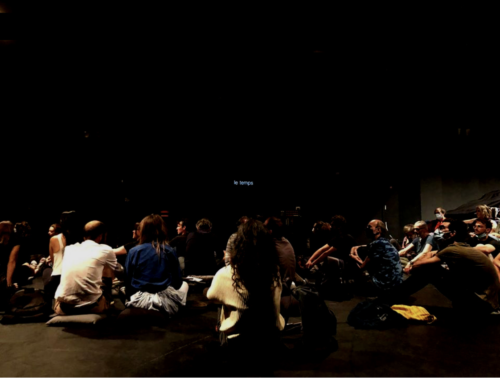

J’aimerais que l’on évoque ensemble ton travail de composition. Ton matériau se base sur l’enregistrement de voix. Est-ce que la nature de ces voix a une importance?
Oui, les voix, c’est la matière essentielle. La voix parlée, mais aussi parfois quelques autres expressions vocales, comme le chantonnement, le sifflement, et tout ce qui peut attester de la présence d’une personne à l’oral, son rire, son souffle ou les exhalaisons inintelligibles entre les mots.
Dans tes premières pièces, la musique est beaucoup plus présente puis elle disparaît peu à peu au profit de silences que tu poses entre les mots et les phrases. Pourquoi ce basculement ? Et quel statut revêtent ces silences?
J’ai constitué, il y a quelques années un ensemble d’enregistrements, que j’utilise depuis, comme un répertoire inépuisable.
Un “réel”, comme point de départ de tout mon travail et auquel je m’empresse de tourner le dos, pour aller, dans la mesure du possible vers une certaine forme d’abstraction.
Je dis juste une « certaine forme », non pas l’abstraction elle-même, bien sûr, car quelles que soient les découpes et les manipulations de mes montages, à l’arrivée, il reste toujours, à l’écoute des pièces, cette échelle humaine, cette présence, même extrêmement fragmentée. La nature de la voix n’est pas ce qui a compté lorsque j’ai commencé ces enregistrements. Il s’agissait surtout d’une rencontre. La rencontre d’une personne prête à jouer le jeu d’un dispositif sans préparation ni texte, sans projet ni même intention préalable délibérée. Je me suis tourné vers quelques personnes de mon entourage, de différents âges, et j’ai essayé de découvrir ce qui en elles constituait, pour moi, l’altérité la plus grande et non la familiarité que l’on pouvait, par ailleurs, partager.
Mes pièces sonores sont des formes creusées et c’est le silence, d’abord, qui m’a permis de fragmenter les enregistrements, de découper les voix. Un silence avant et après chaque son, c’est ce qui donne à ce fragment le statut d’élément. Il permet de l’isoler du flux d’où il provient et de le constituer en une partie à intégrer dans un nouveau tout, cette continuité nouvelle créée au montage. Le silence est l’essentiel structurel de mes pièces. C’est le blanc, le vide nécessaire pour qu’une figure respire et prenne forme dans le temps. C’est aussi ce qui sépare, coupe et scande l’écoute. C’est en même temps ce qui relie, fait le lien entre tous les morceaux du puzzle. Le silence crée la tension, retient l’attention, ménage le suspens et donne à mes pièces cette forme en pointillé. Chaque silence peut être perçu comme une entrée possible mais aussi une sortie de l’écoute, il nous laisse du temps pour penser à ce qu’on vient d’entendre et prépare la venue de ce qui va suivre.
Dans le format de l’installation, pour toute personne au seuil de l’œuvre, chaque silence est un commencement, le début de quelque chose, l’amorce du récit. Il peut également laisser croire que c’est fini. Une autre fonction, encore, pour ce silence : il est, dans un lieu d’exposition, ce qui permet à tout ce qui n’est pas issu de l’œuvre elle-même de continuer à exister, à peu près sans conflit.
Donc, le silence a toujours été là, mais, c’est vrai, qu’au fil des années, il est devenu de plus en plus prégnant, tangible, et a pris la place de la musique, qui dans les pièces plus anciennes avait ce rôle de lien et de guide pour la scansion des voix. La bascule s’est faite quand j’ai fait de plus en plus d’expositions et que ce format a pris le dessus sur les autres. À suivre Les liens invisibles.
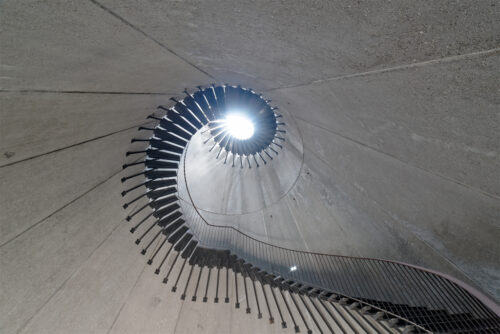
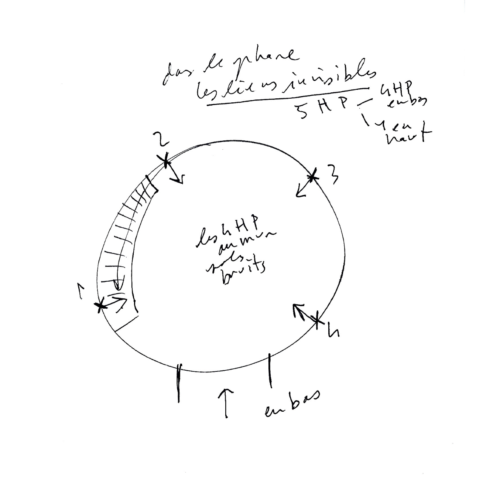
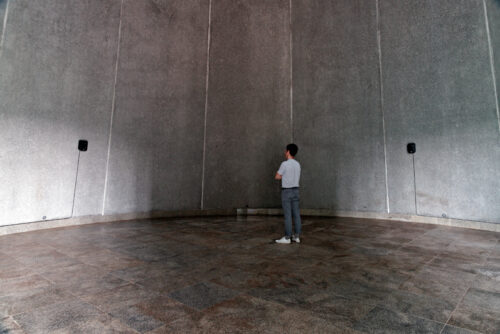
Selon moi, il y a deux moments d’écoute qui s’opèrent pour l’auditeur : la première écoute où l’on cherche à analyser d’où surgissent les sons et quels sont-ils? Et la deuxième où l’on se laisse porter par le récit …
Oui, c’est vrai, j’ai remarqué qu’il peut y avoir différents temps de l’écoute. Comme tu dis, un premier temps dans lequel on cherche et découvre les éléments un par un, et un second temps lors duquel les liens entre ces éléments apparaissent, où l’œuvre se révèle dans sa forme, son unité, et où l’on entre davantage dans le récit.
J’imagine qu’il peut y avoir encore de multiples opérations, d’autres tractations mentales et physiques qui se jouent dans la tête des personnes qui se mettent à l’écoute. Mais ce n’est pas mon intention première de perdre les gens. La façon dont l’œuvre accroche l’attention est toujours importante.
Cependant tes dispositifs scéniques brouillent nos repères spatiaux et la présence des silence, nos repères temporels, comment l’expliques-tu?
Le moment crucial où l’écoute démarre, c’est le point de départ d’une énigme, d’un doute qui se crée, et d’une attente qu’il s’agit de faire fructifier. Car ensuite, ce qui compte pour moi, c’est comment maintenir cette attention, comment prolonger la découverte et donner l’impression qu’il y a toujours quelque chose d’inédit à approfondir, que l’essentiel se révélera peut-être plus loin, plus tard. Dans une installation, le début de l’écoute et tous ses degrés – de l’indifférence à la concentration, – de l’attention vague à l’attention la plus dirigée – ne sont pas les mêmes pour tout le monde, puisque nous sommes libres d’aller et venir. J’ai l’intuition que les découvertes les plus belles sont souvent celles que l’on a faites par soi-même. Quitte à passer par quelques moments de perplexité et de brouillard. C’est le risque et cela peut parfois décourager.
Pour donner un exemple concret, dans un parcours de visite, pour une œuvre avec plusieurs couches réparties dans différents espaces, dont une voix séparée des autres sons, je vais essayer d’isoler cette voix, qui porte le récit, le plus loin possible de l’entrée et de la placer seule dans la dernière salle. Comme un secret qui se dévoile enfin, d’une façon indirecte et retardée. Car une autre chose que je peux dire, c’est que j’ai toujours été conduit par deux mouvements parallèles et contraires : le mouvement qui vient du familier et celui qui va vers l’inconnu. Le plus important, et ce qui détermine mes montages et la répartition des sons dans l’espace, c’est de créer les conditions d’une bascule permanente entre ces deux pôles. Que cette bascule puisse se renouveler à chaque fois dans la tête de la personne qui écoute, je ne pourrais pas dire de façon précise : tous les combien de temps, cela est intuitif, mais peut-être toutes les quelques secondes. Qu’il y ait pour cette personne, à chaque fois qu’elle croit être en terrain connu, un nouvel élément qui la fasse basculer dans l’inconnu le plus total. Comme le vide au bord d’une falaise. Comme une brèche qui s’entrouvre et fait perdre tous les repères. Et puis, quelques secondes plus tard, inversement, faire en sorte que cette impression ne dure pas, qu’un élément reconnaissable, assimilable, appropriable, qui semble proche et renouvelle ainsi le mouvement de l’écoute et la progression intime et cabossée du récit.
J’aimerais que l’on revienne sur ton actualité et l’exposition La distance abolie, en cours au Musée de Nancy. De nouveau après l’exposition au Musée Réattu à Arles en 2022, tu occupes des espaces de natures différentes. Comment ce nouveau contexte peut-il ouvrir ton champ d’investigation?
Ces expositions dans des musées ne sont pas très différentes, parce que les lieux d’art sont souvent des architectures anciennement dédiées à autre chose que l’art. Beaucoup sont d’anciennes bâtisses industrielles ou maisons ou commerces ou encore parc, forêt… Il y a une telle diversité de lieux que cela me pousse à chaque fois à penser un mode de présence et un dispositif spécifiques. J’ai une démarche plus concrète que thématique. Ce sont les espaces qui m’inspirent davantage que la fonction du lieu ou son histoire. Toutefois, je peux dire que ce qu’il y a de nouveau avec ces expositions, c’est que j’ai choisi d’intervenir dans les collections de ces musées sans que les œuvres aient à s’excuser d’exister. Donc d’assumer que les voix accompagnent, habillent, au risque de parasiter, le parcours habituel de visite. Mais je n’ai pas pour autant travaillé avec les œuvres pré-existantes du musée elles-mêmes, je n’ai pas cherché l’illustration ou le commentaire. Je me suis tenu à ce que je fais habituellement : créer les conditions d’une mode d’existence de l’œuvre, qu’elle soit en même temps présente et absente, creusée par les silences, proposant un récit fragmenté, mobile et ouvert. Un récit autonome quant aux autres œuvres, mais qui, dans leur réception, se colore naturellement à leur contact. sans qu’il faille forcer le rapprochement.
Pour parler de l’exposition à Nancy, j’ai éparpillé trois types de présences. Une première série de quatre installations – reprenant le titre La distance abolie – avec plusieurs haut-parleurs fixés aux murs à différentes hauteurs, diffusant dans plusieurs salles une série de séquences vocales très courtes, de paroles découpées mot à mot, parfois syllabes par syllabes, s’effilochant d’un haut-parleur à l’autre, que l’on peut percevoir de loin et communiquant à distance.
Une deuxième série de quatre interphones – Les lointains, œuvre acquise par le musée et qui restera de façon pérenne aux murs de quelques recoins et passages – et dont les séquences sonores sont, elles au contraire en attente, pour une écoute à activer. Une façon de mettre à portée d’oreille de qui s’en approche et lance le son, de se connecter à distance avec des compositions paysagères, des scènes qui semblent prises sur le vif, lointaines et extérieures au musée. Enfin, un troisième mode de présence, dans une petite salle, avec une panoplie de documents et d’éditions à consulter, à lire, au mur, au casque, sur un écran ou sur des tables, comme un mini centre de documentation.
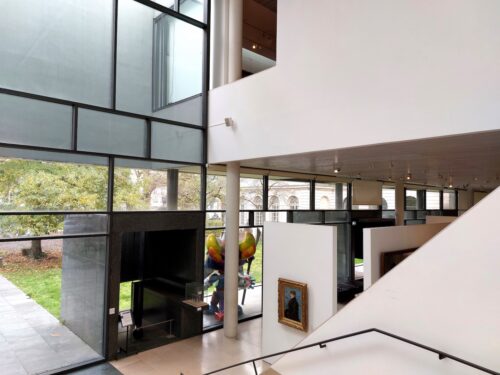


Depuis des années, tu développes aussi des écrits “ Mes écoutes” dont les 170 textes courts explorent tes propres expériences d’écoutes de la vie quotidienne. Quelle est ton attention?
J’ai commencé en 2004. Je voulais parler de la réception des sons, des effets produits, des traces, donc des situations, des contextes et comment mes oreilles et ma pensée se comportaient en toutes sortes de circonstances. Le livre expose quelques souvenirs, des comportements habituels, personnels, des scènes prises sur le vif. Avec l’idée que l’écoute n’est pas normée, obligatoire ou modèle, que tout peut s’écouter de mille manières. J’espère que ces “objets” intimes sont partageables et peuvent faire écho. Ce travail mené en parallèle me permet de contourner une certaine difficulté à enregistrer, cela me disculpe un peu et me permet de rester ouvert au monde autour de moi sans pour autant réaliser une oeuvre.
Lors de nos précédentes conversations, tu as souligné que dans le domaine du son, à l’heure actuelle, l’accent est mis sur une valorisation de l’enregistrement au détriment du montage. Est-ce à dire pour toi de la forme?
Oui, s’agissant de création sonore, je suis sensible à l’invention d’un langage, à ce qui nous confronte à l’inédit d’une forme, à ce qui renouvelle notre écoute plutôt qu’à ce qui nous met juste en présence de quelque chose. Et donc davantage intéressé par les œuvres de montage, de découpe, d’articulation, d’audace dans le rapprochement d’éléments qu’à celles qui valorise l’enregistrement comme une pépite et sacralise le fait d’avoir été là, à la bonne place et au bon moment, pour capter cette chose. Je me sens davantage du côté de la mise en perspective que de la présentation brute, que d’un certain naturalisme.
Qu’est-ce que tu écoutes et comment écoutes-tu de la musique chez toi ou dans des situations publiques…?
Je crains de ne pas être un auditeur très sage et discipliné lors des écoutes publiques. Si j’assiste à un discours ou à une lecture, lors d’un concert, je n’écoute quasiment pas ce qui est dit, les textes m’échappent, mon esprit est ailleurs.
Tout m’intéresse, tout, c’est-à-dire aussi bien la musique bien sûr que la situation elle-même, les à-côtés, le protocole, le dispositif. Mes écoutes domestiques ont évolué en fonction des lieux d’habitation mais aussi des supports. Radio, cassette, vinyle, CD, ordi… autant de supports pour des pratiques différentes : écoute obsessionnelle, concentrée ou flottante, fond musical décoratif, apprivoisement graduel et répété d’un disque, mise en boucle d’un morceau, lecture aléatoire d’un juke-box personnalisé…, je me rends compte que beaucoup d’usages de mes écoutes ont un lien avec la mémoire, sa construction progressive et sa fragilité. Pendant longtemps, mes goûts m’ont davantage porté du côté des formes courtes, chansons, morceaux pop, que de la musique savante. La fréquentation des chansons m’a donné le goût de la miniature. Mais aussi d’une voix au premier plan, soutenue par un arrangement. La fréquentation des musiques de films, écoutées sans les films bien sûr, m’a donné celle du travail de la ponctuation, du déroulé d’une dramaturgie, de la mise en place d’atmosphères. Enfin, les créations ou musiques qui mélangent bruits, voix, notes, matériau réel ou musical, sans hiérarchie, de la vie ou du studio, ont sollicité mes envies de créer à mon tour de tels assemblages.
Propos recueillis par Anne-Laure Chamboissier
Photos © Dominique Petitgand
Photos © Adeline Schumacker-Ville de Nancy
Photos © Véronique Beaudoin
Photos © Aurélien Mole
Photos © CWB



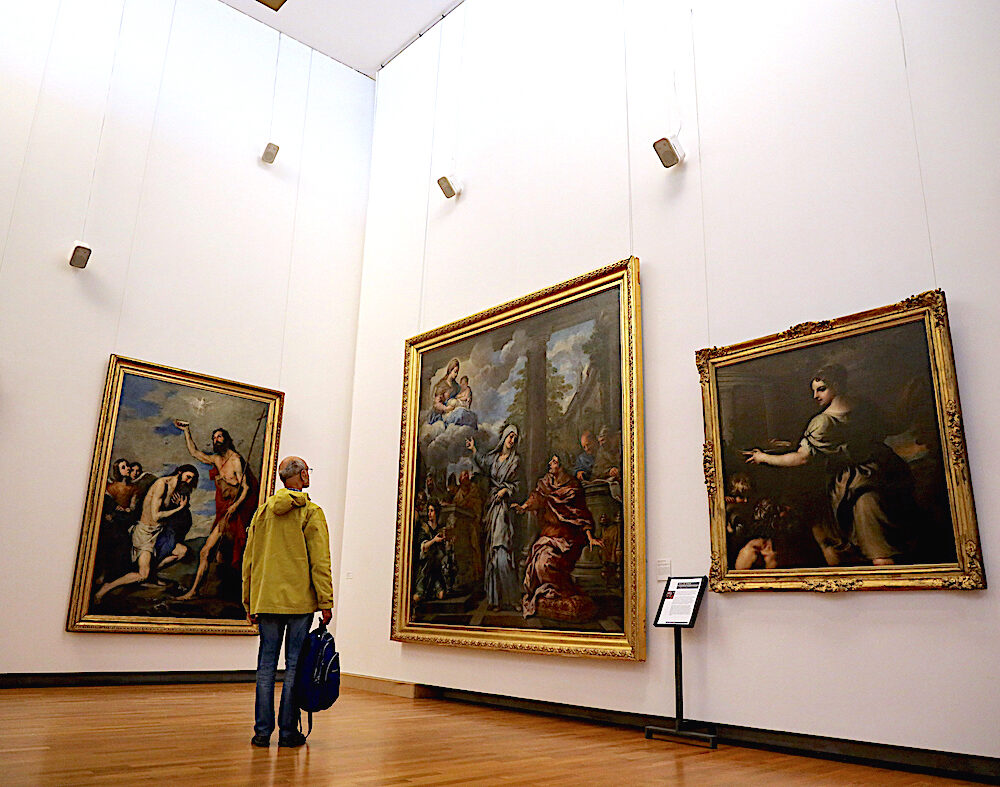)
